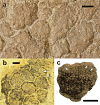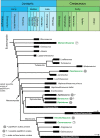Newly detected data from Haestasaurus and review of sauropod skin morphology suggests Early Jurassic origin of skin papillae
- PMID: 35145214
- PMCID: PMC8831608
- DOI: 10.1038/s42003-022-03062-z
Newly detected data from Haestasaurus and review of sauropod skin morphology suggests Early Jurassic origin of skin papillae
Abstract
Discovered in 1852, the scaly skin belonging to Haestasaurus becklesii was the first to be described in any non-avian dinosaur. Accordingly, it has played a crucial role in the reconstruction of sauropod integument and dinosaurs more broadly. Here, we reassess this historic specimen using Laser-Stimulated Fluorescence (LSF), revealing extensive, previously unknown regions of skin that augment prior interpretations of its integumentary morphology and taphonomy. Under white light, polygonal-subrounded, convex scales are visible on one side of the block ('side A'), but LSF reveals extensive smaller and more flattened scales, which are diagenetically fragmented, on the reverse block surface ('side B'). Contrary to the prior interpretation that the visible scales are the epidermal undersides, the presence of convex, intrascale papilliform textures on side A suggests that the external skin surface is exposed. We define intrascale papillae and provide a review of sauropod skin morphology, which clarifies that intrascale papillae are unique to and widespread across stem Neosauropoda, and likely have an evolutionary origin in the Early Jurassic. Intrascale papillae may ultimately have been integral to the evolution of gigantism in this charismatic clade.
© 2022. The Author(s).
Conflict of interest statement
The authors declare no competing interests.
Figures





References
-
- Davis M. Census of dinosaur skin reveals lithology may not be the most important factor in increased preservation of hadrosaurid skin. Acta Palaeontol. Pol. 2014;59:601–605.
-
- Weishampel, D. B. et al. Dinosaur distribution. In The Dinosauria 2nd edn (eds Weishampel, D. B., Dodson, P. & Osmólska, H.) 517–606 (University of California Press, 2004).
-
- Mantell GA. On the structure of the Iguanodon, and on the fauna and flora of the Wealden Formation. Not. Proc. Roy. Inst. Gt. Br. 1852;1:141–146.
-
- Mantell GA. On the Pelorosaurus: an undescribed gigantic terrestrial reptile, whose remains are associated with those of the Iguanodon and other saurians in the strata of Tilgate Forest, in Sussex. Philos. Trans. Roy. Soc. Lond. 1850;140:379–390.
Publication types
MeSH terms
LinkOut - more resources
Full Text Sources

